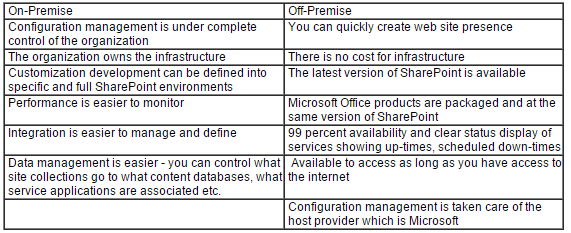SharePoint Service – Deciding Between Cloud and On-premise
 The following article is contributed by Geoff Evelyn, S harePoint MVP and owner of SharePointGeoff.com
The following article is contributed by Geoff Evelyn, S harePoint MVP and owner of SharePointGeoff.com
In terms of providing a SharePoint service, you will need to understand how an effective support model can be provided for SharePoint cloud-based solutions (through Office 365), as opposed to on-premise solutions (through SharePoint on company premises).
The price of bandwidth and storage continues to fall. Office 365 is becoming more and more attractive to small and medium sized organizations. These organizations are committed to reduce licensing costs, not recruiting IT staff. However, you should be aware of this and not assume that the cloud solution is always best. In SharePoint Delivery, no solution is exactly the same in terms of service provision. You should always investigate how benefits can be maximized in the existing setup, and compare those to a cloud based service. Note that using a hybrid model (a combination of on-premise and off-premise SharePoint), that organizations can have the best of both worlds and without long term commitments.
Off-premise SharePoint through Office 365 is an attractive option to small and medium organizations which need to use technology at lower risk and costs. They do not have to invest in hardware or software, and licensing and renewal costs are lower. Total cost of ownership is based on only what is used. Table 8-2 lists a few of the advantages concerning on-premise versus off-premise provision, and Table 8-3 lists a few of the disadvantages concerning on-premise versus off-premise provision.
Table 1-0 Advantages of On-Premise and Off-Premise SharePoint
Table 1-1 Disadvantages of On-Premise and Off-Premise SharePoint
You must carry out a full investigation before taking making a decision to use off-premise, use on-premise, or use hybrid (a combination of the two). To understand whether there is a business case to take on the cloud provision, you should:
- Create a business case identifying the services available from a business agility, cost savings, and service quality perspective.
- Identify what SharePoint solutions can migrate, and carry out a risk analysis to identify whether an off-premise provision is suitable.
- Take into consideration the SharePoint roadmap, particularly if you already have SharePoint on-premise.
- Measure the capability and maturity of your organization and contrast that against what may be expected for SharePoint support services.
- Measure the capability of the SharePoint support services versus the available support off-premise services (especially if you are thinking of adopting a hybrid approach).
- Examine the development model for the off-premise provider; ensure that is manageable and can dovetail into current processes.
The above is taken from the book ‘Microsoft SharePoint 2013: Planning for Adoption and Governance’ located on this link.
Resources

